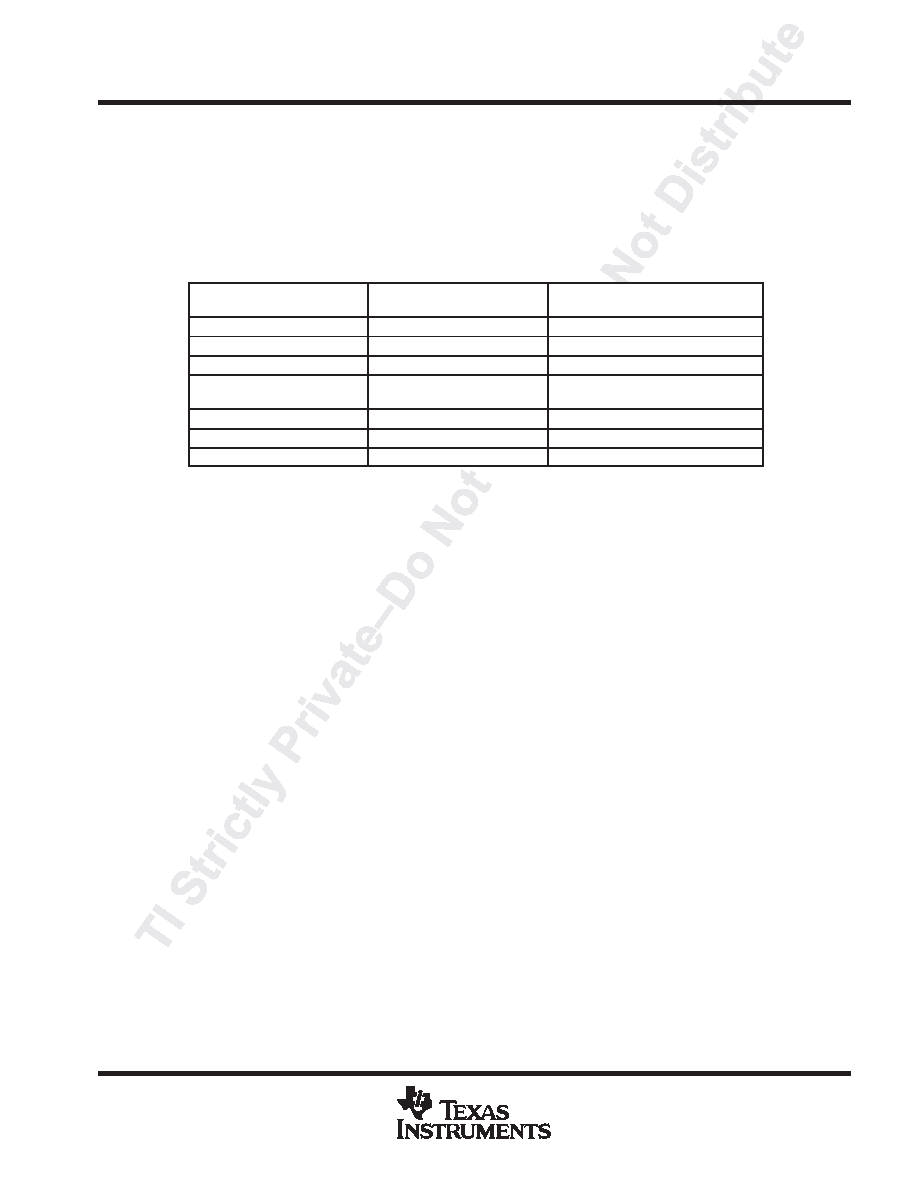- 您現(xiàn)在的位置:買賣IC網(wǎng) > PDF目錄98215 > TFP513PAP (TEXAS INSTRUMENTS INC) SPECIALTY CONSUMER CIRCUIT, PQFP64 PDF資料下載
參數(shù)資料
| 型號: | TFP513PAP |
| 廠商: | TEXAS INSTRUMENTS INC |
| 元件分類: | 消費家電 |
| 英文描述: | SPECIALTY CONSUMER CIRCUIT, PQFP64 |
| 封裝: | 10 X 10 MM, 1.00 MM HEIGHT, 0.50 MM PITCH, HTQFP-64 |
| 文件頁數(shù): | 3/32頁 |
| 文件大小: | 1206K |
| 代理商: | TFP513PAP |
第1頁第2頁當(dāng)前第3頁第4頁第5頁第6頁第7頁第8頁第9頁第10頁第11頁第12頁第13頁第14頁第15頁第16頁第17頁第18頁第19頁第20頁第21頁第22頁第23頁第24頁第25頁第26頁第27頁第28頁第29頁第30頁第31頁第32頁

TFP513
TI PanelBus DIGITAL TRANSMITTER
SLLS611 AUGUST 2004
11
POST OFFICE BOX 655303
DALLAS, TEXAS 75265
T.M.D.S. pixel data and control signal encoding
For T.M.D.S., only one of two possible T.M.D.S. characters for a given pixel is transmitted at a given time. The
transmitter keeps a running count of the number of 1s and 0s previously sent and transmits the character that
minimizes the number of transitions and approximate a dc balance of the transmission line. Three T.M.D.S.
channels transmit RGB pixel data during the active video interval (DE = high). These same three channels also
transmit HSYNC, VSYNC, and three control signals, CTL[3:1], during the inactive display or blanking interval
(DE = low). The following table maps the transmitted output data to the appropriate T.M.D.S. output channel
in a DVI-compliant system.
INPUT PINS
(VALID FOR DE = high)
T.M.D.S. OUTPUT CHANNEL
TRANSMITTED PIXEL DATA
ACTIVE DISPLAY (DE = high)
DATA[23:16]
Channel 2 (TX2
±)
Red[7:0]
DATA[15:8]
Channel 1 (TX1
±)
Green[7:0]
DATA[7:0]
Channel 0 (TX0
±)
Blue[7:0]
INPUT PINS
(VALID FOR DE = low)
T.M.D.S. OUTPUT CHANNEL
TRANSMITTED CONTROL DATA
BLANKING INTERVAL (DE = low)
CTL3, CTL2 (see Note 8)
Channel 2 (TX2
±)
CTL[3:2]
CTL1 (see Note 8)
Channel 1 (TX1
±)
CTL[1]
HSYNC, VSYNC
Channel 0 (TX0
±)
HSYNC, VSYNC
NOTE 8: The TFP513 encodes and transfers the CTL[3:1] inputs during the vertical blanking interval. The
TFP513 internally generates CTL3 for HDCP operation and the CTL[2:1] inputs are reserved for
future use. When DE = high, the CTL and SYNC pins must be held constant.
universal graphics controller interface voltage signal levels
The universal graphics controller interface can operate in the following two distinct voltage modes:
D The high-swing mode where standard 3.3-V CMOS signaling levels are used.
D The low-swing mode where adjustable 1.1-V to 1.8-V signaling levels are used.
To select the high-swing mode, the VREF input pin must be tied to the 3.3-V power supply.
To select the low-swing mode, the VREF input range must be 0.55 V to 0.9 V.
In the low-swing mode, VREF sets the midpoint of the adjustable signaling levels. The allowable range of values
for VREF is from 0.55 V to 0.9 V. The typical approach is to provide VREF to the chip using a simple voltage-divider
circuit. The minimum allowable input signal swing in the low-swing mode is VREF ± 0.2 V. In low-swing mode,
the VREF input is common to all differential input receivers.
universal graphics controller interface clock inputs
The universal graphics controller interface supports both single-ended and fully differential clock input modes.
In the differential clock input mode, the universal graphics controller interface uses the crossover point between
the IDCK+ and IDCK signals as the timing reference for latching incoming data (DATA[23:0], DE, HSYNC, and
VSYNC). Differential clock inputs provide greater common-mode noise rejection. The differential clock input
mode is only available in the low-swing mode. In the single-ended clock input mode, the IDCK+ input (pin 57)
must be connected to the single-ended clock source and the IDCK input (pin 56) must be tied to GND.
The universal graphics controller interface provides selectable 12-bit, dual-edge and 24-bit, single-edge input
clocking modes. In the 12-bit, dual-edge mode, the 12-bit data is latched on each edge of the input clock. In the
24-bit, single-edge mode, the 24-bit data is latched on the rising edge of the input clock when EDGE = 1 and
the falling edge of the input clock when EDGE = 0.
DKEN and DK[3:1] allow the user to compensate the skew between IDCK
± and the pixel data and control
signals. See the description of the CTL_3_MODE register for details.
相關(guān)PDF資料 |
PDF描述 |
|---|---|
| TFP6422PAP | SPECIALTY CONSUMER CIRCUIT, PQFP64 |
| TFP6424PAP | SPECIALTY CONSUMER CIRCUIT, PQFP64 |
| TFP9431CPAP | SPECIALTY CONSUMER CIRCUIT, PQFP64 |
| TG355ENK-7916 | 8.15 MHz, LOW PASS FILTER |
| TH355BDI-4957 | 4.43 MHz, BAND PASS FILTER |
相關(guān)代理商/技術(shù)參數(shù) |
參數(shù)描述 |
|---|---|
| TFP513PAPG4 | 制造商:TI 制造商全稱:Texas Instruments 功能描述:TI PANELBUS DIGITAL TRANSMITTER |
| TFP5N60 | 制造商:TAK_CHEONG 制造商全稱:Tak Cheong Electronics (Holdings) Co.,Ltd 功能描述:N-Channel Power MOSFET 4.5A, 600V, 2.4Ω |
| TFP61 | 制造商:HOFFMAN ENCLOSURES 功能描述:COOLING FAN PACKAGE, 6 IN;115V 50/60HZ;; 制造商:Pentair Technical Products / Hoffman 功能描述:COOLING FAN 140CFM 32W 制造商:HOFFMAN ENCLOSURES 功能描述:COOLING FAN, 140CFM, 32W 制造商:Pentair Technical Products / Hoffman 功能描述:COOLING FAN, 140CFM, 32W; Enclosure Material:ABS; Body Color:Black; External Height - Imperial:7.80"; External Height - Metric:198mm; External Width - Imperial:8.87"; External Width - Metric:225mm; External Depth - Imperial:3.8" ;RoHS Compliant: Yes |
| TFP61SS | 制造商:Pentair Technical Products / Hoffman 功能描述:115V,50/60Hz,36/32W,0.45/0.36A ;RoHS Compliant: Yes |
| TFP61UL12 | 制造商:HOFFMAN ENCLOSURES 功能描述:Fan;Cooling Fan Exhaust Package;115V,50/60Hz,36/32W,0.45/0.36A;5x8.5x9 制造商:Pentair Technical Products / Hoffman 功能描述:COOLING FAN, 60CFM, 32W; Enclosure Material:ABS; Body Color:Black; External Height - Imperial:7.8"; External Height - Metric:198mm; External Width - Imperial:8.9"; External Width - Metric:225mm; External Depth - Imperial:3.8" ;RoHS Compliant: Yes |
發(fā)布緊急采購,3分鐘左右您將得到回復(fù)。